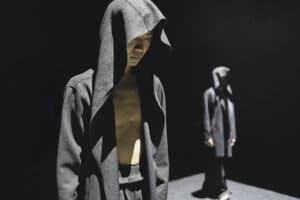30 Artists, 30 Years – Hu Shenyuan
BF: We would be delighted if you could tell our audience a bit more about your background performing dance in China.
HS: I started to learn gymnastics at the age of three. It wasn’t until I was 7 that I started to take amateur traditional Chinese dance. It included folk dance and classical Chinese dance training. The first performance was to participate in a training class, and there was an annual presentation every year. At that time, there was only one boy in the class, so I became the lead dancer. It is also this kind of opportunity that allows me to stand tall whilst performing. It was right around when I was about 10 years old that I began to gradually feel that maybe dance can become a profession in the future and I want to love it.
我是从小时候三岁开始学习的体操,在我7岁的时候才进入业余舞蹈的学习,学习的是中国传统舞,包括民族民间舞和中国古典舞的培训。第一次表演是参加培训班,每年有年度汇报,那时候班里只有一个男孩,所以我就作为主角,可能是领舞的身份在前面。也是这样的机缘可以有让我站在前面表现的机会,也是从大概10岁左右才开始慢慢觉得也许未来舞蹈是可以成为一种职业想去热爱它。

BF: Is Samsara the first major co-choreographed international collaboration you have undertaken? When did you meet Aakash and how has the collaboration experience been for you, especially communicating through movement rather than language?
HS: Samsara is my first time collaborating and working with an international choreographer. During this process, there were differences between the East and West culture as well as the difference in choreographic methods. When I first met Aakash, I thought he is someone with a lot of ideas! Indeed during rehearsals, you discover he is a director and actor with infinite ideas which he tries to realize. I think the communication between dancers may not be that difficult, because our physical perception is interlinked, and we also have similar religious and cultural backgrounds. When we discuss certain points and opinions, we end up heading towards the same direction. This is a very magical journey which a result of our communication through our eyes and soul.
无径之径算是我和国际编舞的第一次合作与尝试,在这个过程里面有东西方文化的不同和编舞方式的不同 认识阿卡什的时候觉得他是一个非常想法的人。确实在排练的时候也发现他是有无数idea的编导和演员,他有非常多的想法并且都想去把他们实践。 我想舞者与舞者的之间交流或许没有那么困难,因为大家身体的感知是相通的,也有相似的宗教文化的背景,当我们在谈论到一些知识点和一想法的时候,我们的想法会去到一致的方向。这是一个很神奇的过程,就是靠眼睛和心灵的交流。
BF: How have you seen the dance sector in China change over your career and what do you think is next for the international dance scene in your home country? What’s next for you?
HU: With the continuous progress of China in recent years, more and more Chinese people are starting to pay attention to dance and also understanding contemporary dance. Therefore, contemporary dances is also an art discipline that is gradually gaining an audience in China. So to continue the development in China is very optimistic in the future. Of course, in China, we need to export more works and themes about our Chinese tradition, which have their own voice and identity. In the future, I hope to discover more materials and elements with Chinese stories and using contemporary dance to tell that story to the international audience and also to our own people.
随着中国这些年不断的进步,也有越来越多的中国老百姓开始关注舞蹈并且他们了解了现代舞。所以现代舞在中国也是开始逐渐有观众群体的一个艺术门类,在中国发展我想是很可观的,未来我是非常看好的。当然在中国我们需要对外输出的是更多的关于我们中国传统,有自己语言地位和自己身份认同的作品和主题。
在未来我希望挖掘更多中国题材和有中国元素的故事 用现代舞语境下,讲给外国人听,讲给自己人看。
BF: Can you share your most significant career achievement and how your previous experience defined the work with Aakash on Samsara?
HS: I think every dancer or choreographer will accomplish many achievements along the journey, but I don’t think I can say that they are important because we have a lot of important things. However, they will eventually become the past, so each achievement lays the path of the next footstep. So when I accomplish any achievements, I see it as a driving force for progress.
The duo-choreography arrangement is something I have never experienced before, so my collaboration with Aakash is also a new way of working – and the two of us are also exploring collaboration methods beyond the conventional way.
我想每一个舞者或者编导在路上都会取得很多成就,但是我并不认为这些我可以把它们说成重要的,因为说重要的话我们都有很多。因为它们都会成为过去,每一个成就奠定着下一步的脚印。所以当我取得任何成就时,我觉得都是前进的动力。在之前的经验里这样编排双人舞的方式—没有。所以跟阿卡什的合作也是一种新的方式,而且我们两个也在探寻一些常规意义之外的一些配合和方式。

Biography
Hu Shenyuan is an independent dancer and choreographer. He graduated from the Dance Academy of Central MinZu University before working in Beijing for LDTX Dance Company from 2012 to 2014. As a dancer, he played Yu Ji in Yang Liping’s dance work Under Siege to great public acclaim. In 2017, Hu became the first young artist supported by Yang Liping Art Foundation, created his work Roving and established his studio Hu-Hu Dance. Hu’s choreographic works include Roving, The Moonlight Rainbow, So Close, With, ID, Ego, and Super-Ego and The Flower of Freedom. Several of his creations have been selected for the exhibition unit of the China Youth Dance Talents Training Program. His many awards include Best Performance Award at the 4th Beijing International Ballet and Choreography Competition; the Silver Award from the 16th Italian Rome International Choreography Competition and the Jury Chairman’s Award at the 15th Seoul International Dance Competition in 2018.
Interviewed by Chelsea Pettitt, Head of Arts – May 2020.


